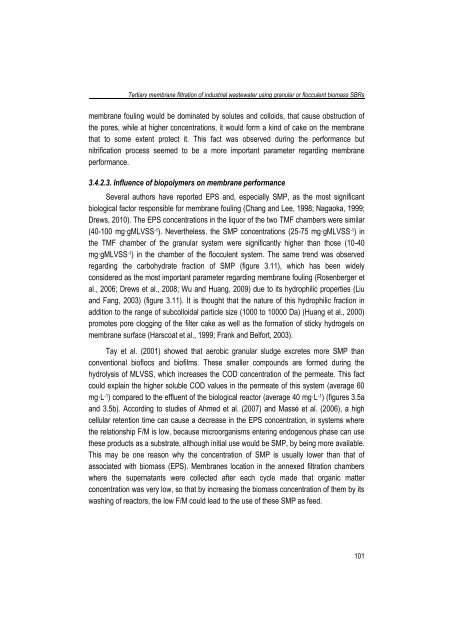Combining submerged membrane technology with anaerobic and ...
Combining submerged membrane technology with anaerobic and ...
Combining submerged membrane technology with anaerobic and ...
Create successful ePaper yourself
Turn your PDF publications into a flip-book with our unique Google optimized e-Paper software.
Tertiary <strong>membrane</strong> filtration of industrial wastewater using granular or flocculent biomass SBRs<strong>membrane</strong> fouling would be dominated by solutes <strong>and</strong> colloids, that cause obstruction ofthe pores, while at higher concentrations, it would form a kind of cake on the <strong>membrane</strong>that to some extent protect it. This fact was observed during the performance butnitrification process seemed to be a more important parameter regarding <strong>membrane</strong>performance.3.4.2.3. Influence of biopolymers on <strong>membrane</strong> performanceSeveral authors have reported EPS <strong>and</strong>, especially SMP, as the most significantbiological factor responsible for <strong>membrane</strong> fouling (Chang <strong>and</strong> Lee, 1998; Nagaoka, 1999;Drews, 2010). The EPS concentrations in the liquor of the two TMF chambers were similar(40-100 mg·gMLVSS -1 ). Nevertheless, the SMP concentrations (25-75 mg·gMLVSS -1 ) inthe TMF chamber of the granular system were significantly higher than those (10-40mg·gMLVSS -1 ) in the chamber of the flocculent system. The same trend was observedregarding the carbohydrate fraction of SMP (figure 3.11), which has been widelyconsidered as the most important parameter regarding <strong>membrane</strong> fouling (Rosenberger etal., 2006; Drews et al., 2008; Wu <strong>and</strong> Huang, 2009) due to its hydrophilic properties (Liu<strong>and</strong> Fang, 2003) (figure 3.11). It is thought that the nature of this hydrophilic fraction inaddition to the range of subcolloidal particle size (1000 to 10000 Da) (Huang et al., 2000)promotes pore clogging of the filter cake as well as the formation of sticky hydrogels on<strong>membrane</strong> surface (Harscoat et al., 1999; Frank <strong>and</strong> Belfort, 2003).Tay et al. (2001) showed that aerobic granular sludge excretes more SMP thanconventional bioflocs <strong>and</strong> biofilms. These smaller compounds are formed during thehydrolysis of MLVSS, which increases the COD concentration of the permeate. This factcould explain the higher soluble COD values in the permeate of this system (average 60mg·L -1 ) compared to the effluent of the biological reactor (average 40 mg·L -1 ) (figures 3.5a<strong>and</strong> 3.5b). According to studies of Ahmed et al. (2007) <strong>and</strong> Massé et al. (2006), a highcellular retention time can cause a decrease in the EPS concentration, in systems wherethe relationship F/M is low, because microorganisms entering endogenous phase can usethese products as a substrate, although initial use would be SMP, by being more available.This may be one reason why the concentration of SMP is usually lower than that ofassociated <strong>with</strong> biomass (EPS). Membranes location in the annexed filtration chamberswhere the supernatants were collected after each cycle made that organic matterconcentration was very low, so that by increasing the biomass concentration of them by itswashing of reactors, the low F/M could lead to the use of these SMP as feed.101
















